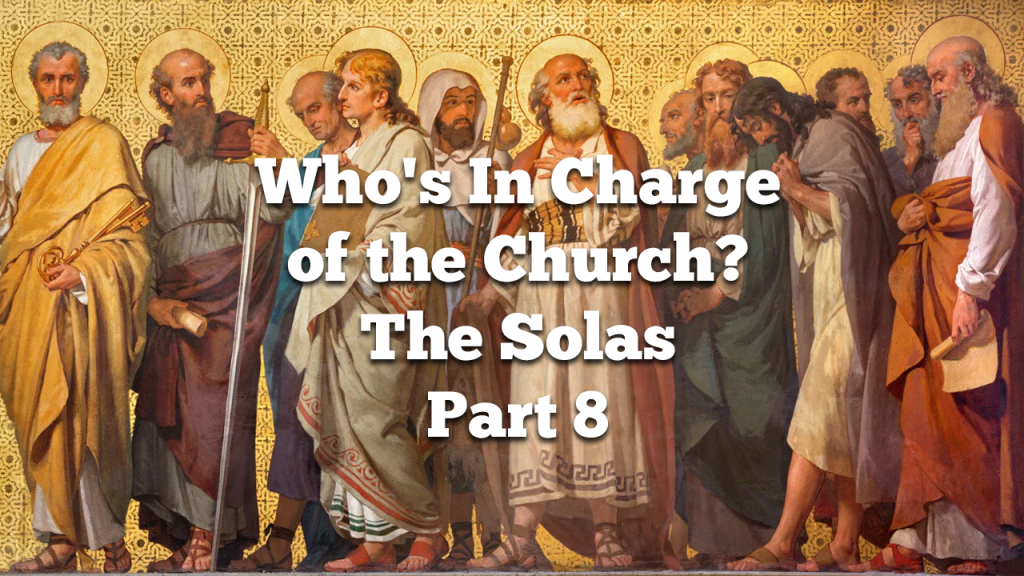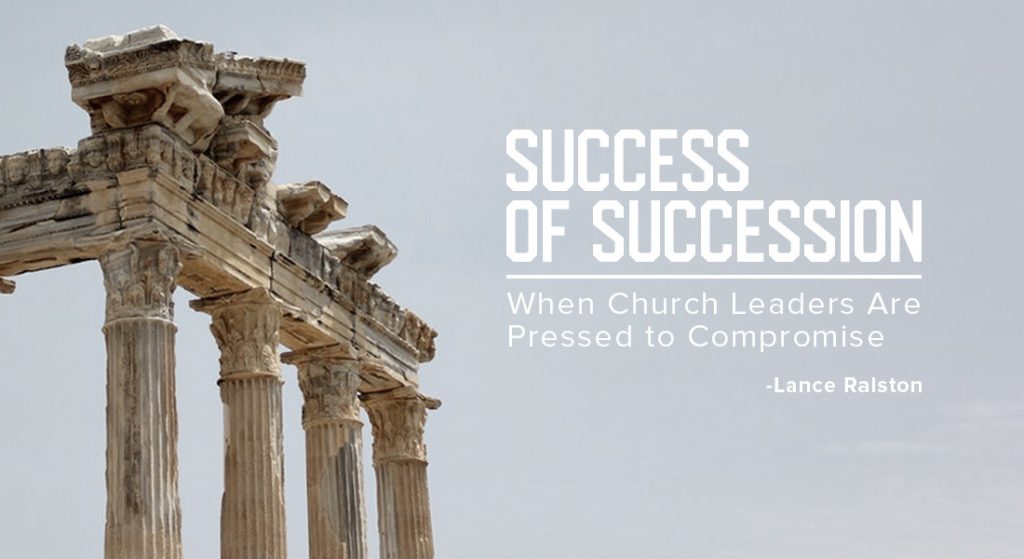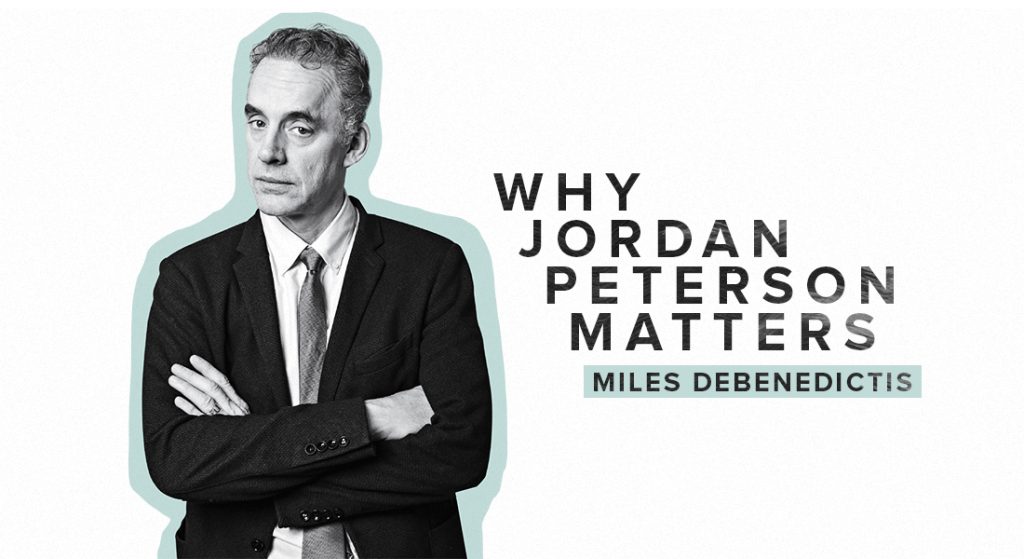This article is the eighth and last of a series on the “Solas” of the Protestant Reformation. They will post each Thursday here on The Post.
Who’s in charge of the church? Who’s in authority over the church? The pastor? A bishop? A priest? Elders? A board of directors or deacons? The pope?
The correct answer—the biblical one—is none of the above. Jesus Christ alone is the founder and Head of the church—the Body of Christ. However, the New Testament speaks of priests, pastors, and bishops. Are certain people given special places of authority over people within the church? Well, yes, and no.
A characteristic of the early church, and almost every period of revival since then, could be termed organic leadership. This would include leaders who break away from existing institutional leadership or step up despite resistance and even in defiance of institutional leadership. The Protestant Reformation movement of the 16th century was a response to corruption in the medieval Catholic Church.
Although Martin Luther may be the most well-known of the reformers, John Wycliffe and John Hus were earlier leaders that led to a move back to a more biblical foundation of doctrine, practice, and leadership. Organic leadership was at the heart of the Neo-Pentecostal movement at the turn of the 20th century. It was also true at the beginning of the Jesus People Movement in the mid-sixties and into the early seventies.
Along with fresh new leaders, many young believers were empowered to step up and serve within the church in various ways during the Jesus People Movement, which became known and described as body ministry. People within the Body of Christ—the church community—were empowered by leaders to do ministry or service. This was a fulfillment of what the apostle Paul said church leaders were to do—to equip believers for ministry.
This was an important principle of the Protestant Reformation. This reforming of the church took it back to its biblical foundations based on the theological truths of the 5 Solas, found in the Apostles and Nicene Creeds. What we call body ministry now was known as the priesthood of all believers.
Do you want to see revival?
The 5 Solas provide the bedrock of theology for the church—the Body of Christ—to function as Jesus intended. What does this look like in action? The early chapters of Acts provide some excellent insights into the formation of the first church, even and even in later chapters when new people groups were reached with the gospel and new churches established.
When I hear believers say they want to “see revival,” I wonder what they mean or expect. What we see in the book of Acts is taking place in many parts of the world now. There is a caveat, however. A fresh work of God produces new leadership, but these new leaders need equipping.
This is why Paul spent a year in Antioch, a year and a half in Corinth (Acts), and two years in Ephesus teaching the believers while reaching out with the gospel in surrounding areas (Acts 11:26; 18:11; 19:10).
When the Holy Spirit empowers new leaders and believers for the ministry God calls them to do, they still need the example and guidance of more experienced leaders. Even those of us with experience often need the influence of the fresh new life and vision of young leaders.
The Holy Spirit gave the apostle Paul vision for this need of equipping God’s people for the work of the ministry in Ephesians 4:11-16. In that text, Paul outlines why leaders are needed for a healthy church body (community)—
…to equip his people for works of service, so that the body of Christ may be built up until we all reach unity in the faith and in the knowledge of the Son of God and become mature, attaining to the whole measure of the fullness of Christ. (Eph 4:12-13 NIV)
This is not a New Testament concept. It’s always been God’s design for His people to be a kingdom of priests. But Israel chose to reject this by telling Moses they didn’t want to hear from God directly (Exo 19:5-6; 20:19). The church, the community of God’s people, can’t afford to make a similar mistake. This equipping of the body of believers needs to be done “in-house” (local church bodies), not farmed out to academic institutions, although there is certainly a place for colleges and seminaries.
If you and I want to see revival, we need to see churches equipping God’s people and young leaders continuously. It may be through some formalized system of equipping (school of ministry), or through various leaders within the church body. This is not just in Northern America (or wherever you are) but throughout the world. This is a tremendous need in many nations where God is already moving in a fresh way.
A priesthood of all believers
It was never God’s intention for there to be a formal distinction between God’s people and their leaders. You won’t find the terms clergy and laity in the Bible, They’re manmade.
There is no basis for a formal priesthood or leadership in the New Testament, except to explain the distinction between the Old and New Covenants (Testaments). This is made clear in the book of Hebrews, especially in chapters 7–10. Even when Jesus is called our High Priest, it’s in a distinct sense from the priesthood of Israel (Hebrews 8:6).
We see a clear, biblical view of the priesthood of all believers in the first epistle of Peter—
As you come to him, a living stone rejected by men but in the sight of God chosen and precious, you yourselves like living stones are being built up as a spiritual house, to be a holy priesthood, to offer spiritual sacrifices acceptable to God through Jesus Christ.
But you are a chosen race, a royal priesthood, a holy nation, a people for his own possession, that you may proclaim the excellencies of him who called you out of darkness into his marvelous light. (1 Peter 2:4-5, 9)
This is also echoed in the book of Revelation (Revelation 1:6; 5:10; 20:6). All believers don’t have the same calling, gift, or role within the Body of Christ, but one thing is clear—Jesus is in charge of His church.
The 5 Solas and the priesthood of all believers
So, how do the 5 Solas factor into this principle of the priesthood of all believers? Here’s my own simple summary—
- Soli Deo Gloria — The primary purpose of the church is to glorify God as His living testimony on earth, as the Body of Christ (Acts 1:8; 1 Peter 2:9)
- Solus Christus — There is only one mediator between God and man and Jesus, alone, is the Head of the Body of Christ (1 Timothy 2:5; Colossians 1:18)
- Solo Gratia — It is only by the grace of God that we’re included in the church and how we are to serve the Lord in whatever way He gifts and calls us (Romans 12:3-8)
- Solo Fide — The church is not an institution, but an organism—a living body of believers—who are to begin and continue in faith (Galatians 3:1-3)
- Sola Scriptura — The Scriptures (the Bible) are the sole basis of authority for all matters of faith, and this includes how the church is to function as the Body of Christ (John 6:63; 8:31-32; 17:17; Ephesians 4:11-16)
As said before, God’s intention is for all believers to be involved in the church as part of a community under the direction of the Holy Spirit and the leaders God raises up. Do people within a church need to submit to recognized leaders? Yes, as long as the leadership doesn’t violate the essence of these 5 Solas and become abusive and overbearing.
If you’ve experienced some form of abusive leadership connected to a church, then I encourage you to not give up on the church. Seek out a community of believers and leaders who genuinely and humbly honor the Lord and the truths of these 5 Solas. Sure, there are failures and problems, but the Body of Christ is what Jesus established. When things are not right, He will bring reform and revival.
If you love Jesus, be ready for what He wants to do on earth, and ready for His return. The time is short and billions still need to hear God’s story of redemption.
Trip planted a church in the US and established two ministries overseas, along with many other ministry experiences. His ministry now focuses on discipleship and leadership development, while serving as a mentor to pastors and leaders with Poimen Ministries. Along with writing devotionals and simple Bible studies, he’s written books, Bible study guides, and training materials. Trip’s material can also be found at
@tkbeyond (on X)
@tripkimball (on https://substack.com/)




